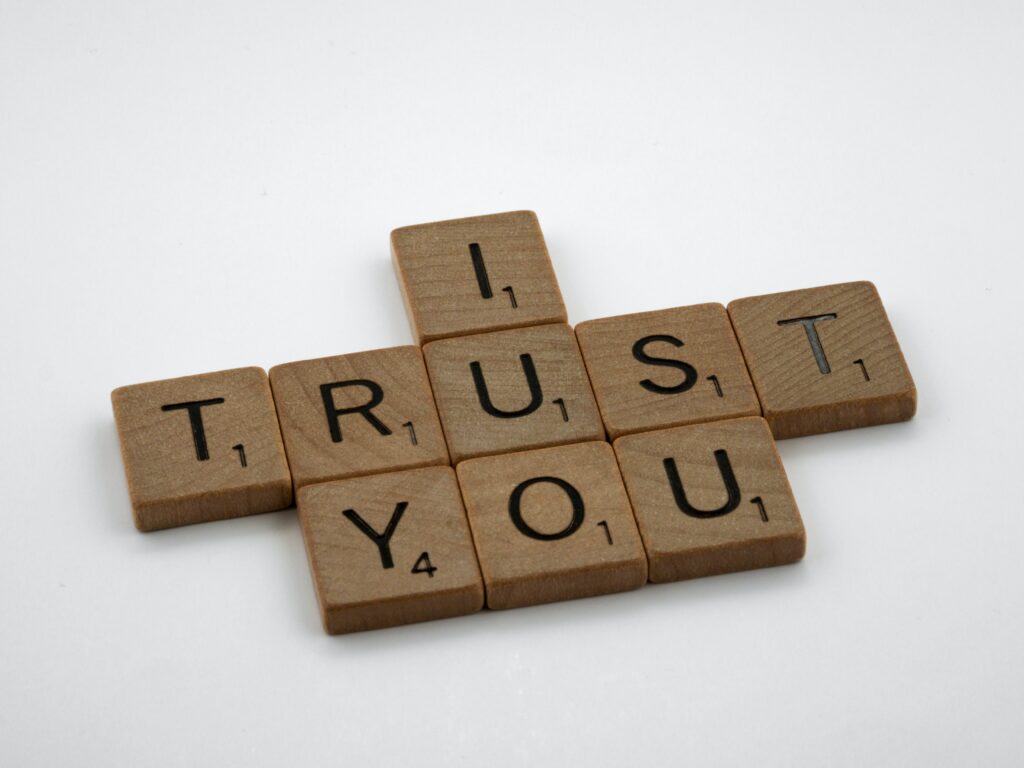Building Trust in the Workplace: 9 Steps for Creating a High-Trust Company Culture

The success of any organization depends heavily on its ability to build trust in the workplace. Check out these nine steps you can take to make it happen.
What’s the number one ingredient for a successful company culture? Is it above-average salaries? A cool office space? Great perks and benefits?
While these are all important components, studies indicate that the single most important component of company culture is trust in the workplace.
In fact, 55% of CEOs think a lack of trust is a threat to their organization’s growth. It’s no wonder, especially when you consider the fact that people at high-trust companies have reported:
- 74% less stress
- 50% higher productivity
- 76% more engagement
- 40% less burnout
- 13% fewer sick days
The trick is understanding how to effectively—and permanently—establish a culture of trust within your organization and creating an action plan to achieve it.
Here’s how to do it.
9 Steps for Building Trust in the Workplace
Here’s the thing about trust in the workplace: it can’t be magically created with the snap of a finger. It’s something that has to be earned with dedication and consistent action over extended periods of time.
Take these nine steps to establish it within your business.
1. Start from the Top Down

In any organization, regardless of its size, a culture of trust has to start at the top and trickle down throughout the company.
That means that your organization’s leadership needs to take the reins on initiatives that will help build trust in the workplace.
One great way to do this is by participating in leadership group skills training programs that can help leaders develop the skills they need to earn the trust of their team members.
Only once your leadership team has put the time and effort into building trust at the top of the organization will they be able to instill that trust throughout the rest of the business.
2. Be Honest and Open
This may seem obvious but being open and honest with your team is critical in your efforts to build trust in the workplace.
The trick is that you need to be open and honest even when it’s uncomfortable or challenging, not just when it’s easy.
This can include but is not limited to:
- Taking responsibility for your failures
- Admitting when you’ve made a mistake
- Acknowledging when you don’t know something
- Explaining your thought process when it comes to decisions you’ve made or how you want people to approach a task or deliverable
- Implementing open and transparent practices, such as sharing high-level company news like business strategy and performance metrics to ensure your team members feel like they’re engrained with the organization, understand how their contributions impact its success, and realize that they’re valued as deep-rooted members of the business
3. Implement Strong Feedback Processes

As an extension of being open and honest, a strong and consistent feedback process is a key part of building trust in the workplace—even when it’s not necessarily positive.
Great feedback is:
- Specific and Timely – Feedback should be specific, have a clear business focus, and be discussed as soon as possible. Positive or constructive, don’t let feedback wait too long.
- Direct – Never give constructive feedback publicly. Doing so will only serve to embarrass the recipient of the feedback, in turn breaking their trust in you as a leader and making them feel alienated. Always connect with colleagues directly, on a one-on-one basis, in order to give feedback.
- Unbiased – As a leader, it’s important that you’re able to remove ego from the equation and give feedback based solely on facts.
- Goal-Oriented and Actionable – Make sure your feedback is actionable. Never leave a team member wondering “now what?” once you’ve given it to them.
- Backed by Solutions and Tools – In addition to being actionable, make sure your feedback is backed up by solutions, tools, and support.
- Reinforced with Positivity – Don’t just dump constructive feedback on an employee and let them walk away. Leave them with a positive takeaway. Doing so will help boost their motivation and help ensure the feedback is actioned.
- Two-Way – This is arguably the most important feedback tactic when it comes to building trust. Don’t just give feedback. Request it from your team members proactively. Let them know that you’re striving to learn, grow, and improve as well, and their feedback is important in helping you do so. By taking their feedback and putting it to action, you’ll earn their trust in a big way. If you’re looking for ways to collect feedback from your team, you might want to check out our Employee Engagement Survey Questions, Template, and Tips.
To learn more about how to give productive and actionable feedback, check out our Performance Management Fundamentals program which will teach you the performance management cycle, how to build performance-driven relationships, how to coach colleagues more effectively, and how to measure performance more accurately.
4. Avoid Micromanaging
“Sometimes the best way to build trust is to give trust. And one great way to do this is to avoid micromanaging as much as humanly possible,” says Dima Suponau serial entrepreneur and founder at extensionfile.net
Assign tasks to employees, provide them with a deadline, and ensure they have all the tools they need to do their job effectively.
Then, let them handle it and be there for them as they need it.
This is easier said than done since, as a leader, you’re responsible for the ultimate outcome of their work. But it’s important to show them that you have faith in their abilities.
Once they’ve completed the task, sit down for a formal feedback discussion to talk through the things that went well as well as where there are opportunities for development.
Trusting your employees empowers their best work and encourages them to trust you back.
5. Get to Know Your Team on a Personal Level (and Help Them Get to Know You)

Don’t underestimate the value of personal bonds. While it’s important to keep your professional relationships professional, developing personal connections allows you to see your staff for who they are and to better understand them—and vice versa.
In-person and Virtual Team building activities are a great way to connect with your colleagues in a personal way while still achieving some professional benefits while you’re at it.
You might like:
- Clue Murder Mystery: You’ve probably never heard of Neil Davidson, but in this mysterious team building activity, you and your team will need to work together to analyze clues, review case files, and determine who had the means and the motive to commit a deadly crime.
- Virtual Social Shuffle: When it comes to getting to know your team, there’s no better choice than Social Shuffle. We created this team building activity for that sole purpose of helping colleagues get to know one another—and to have fun doing it! With Social Shuffle, you and your colleagues can connect, collaborate, and build relationships as you work together to complete themed challenges. Every challenge is designed to inspire conversation and help build bonds between teammates.
- Virtual Game Show Extravaganza: This team building activity puts you and your colleagues “on the set” of your very own game show. You’ll need to tap into your knowledge banks and communicate effectively as you work in teams to answer trivia questions with topics ranging from pop culture to sports, world history, and beyond.
If you’re looking for something a little less formal, you might want to check out our list of The 164 Best Team Building Icebreaker Questions for Work. These are a great way to get to know your colleagues better and to have some fun in the process.
6. Lead by Example
The point here is simple: as a leader, talk is cheap. You need to live and breathe what you expect from your team if you want them to trust you.
This includes (but is certainly not limited to):
- Treating people with respect
- Steering clear of office gossip and cliques
- Being honest and transparent
- Owning mistakes and admitting when you’ve dropped the ball
- Giving praise and supporting your colleagues
Don’t just talk the talk. Walk the walk and be a shining example of what you want to see from your team.
7. Say What You Mean and Do What You Say
One of the fastest ways to break trust with your colleagues is to break your word. To build trust, you need to make sure you follow through with and put action behind your words and commitments.
If you promise to do something, make sure you do it.
And if, for any reason, you won’t be able to keep your word to a team member, make sure you’re proactive in letting them know and explaining the reasons why.
8. Boost Your Emotional Intelligence

A study comparing outstanding managers with average ones found that 90% of the difference was accounted for by emotional intelligence for leaders.
And your ability to manage employees with emotional intelligence is integral in building trust with them. It allows you to be acutely aware and understanding of both your own emotions and those of your team members so that you can better manage and work with them.
To learn actionable steps you can take to increase your EQ, check out this comprehensive article we wrote on the topic: The What, Why, and How of Developing Emotional Intelligence for Leaders.
9. Don’t Hold Back on Giving Praise
Last but certainly not least, don’t hold back on giving praise when it’s due. And don’t wait to give praise either. If you see a team member going above and beyond or doing outstanding work, let them know that you recognize and appreciate it right away.
You can do this in any number of ways, from verbal recognition to rewards. But however you choose to do it, make sure it’s a priority.
At the end of the day, building trust in the workplace will make for a stronger and more successful organization.
Take the necessary steps to build trust over time and your team and your business will reap the benefits in the long run.
Learn More About How to Build Trust in the Workplace
If you’ve got questions about team building and group skills training programs that can help build trust in the workplace, reach out to an Employee Engagement Consultant.




Comments